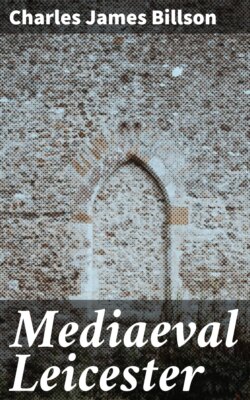Читать книгу Mediaeval Leicester - Charles James Billson - Страница 11
На сайте Литреса книга снята с продажи.
IV. THE WEST QUARTER.
ОглавлениеTable of Contents
The remaining quarter of the town is that contained by the Town Wall on the North, the river on the West, the High Street on the East, and Hot Gate and Applegate on the South.
It comprised the ancient Churches of St. Nicholas and St. Clement, and the Monastery of the Black Friars, which occupied 16 acres. There, too, lay the old Blue Boar Inn, and the earliest halls of the Guild Merchant.
Among the few lanes in this quarter were the Guildhall Lane, St. Clement's Lane, Friars' Causeway, Deadman's Lane, Jewry Wall Street, and Talbot Lane.
The Guildhall Lane was described in 1301 as "the lane which leads from the High Street to the Moothall"; and in 1341, when it was paved, as "the lane towards the Guildhall." In the next century it was called "Mayor's Hall Lane." It ran out of the High Street by the side of the Blue Boar Inn, and has since been known unto the present day as Blue Boar Lane — a name said by Hutton to have been at one time corrupted into "Blubber Lane."
St. Clement's Lane was a long passage running from the North Gate westward to the Black Friars and St. Clement's Church, and afterwards turning south, and passing between the grounds of the Black Friars and the backs of the houses which stood facing the old High Street opposite All Saints' Church. It was also known as "The Black Friars Lane." Thus, the first Town Ward of 1484 beginning at the High Cross extended to "the Black Friars Lane." Another name was "the lane of the Friars Preachers." The parcels contained in a deed of 1498 throw some light upon the topography of this quarter. Four cottages were demised which lay together "in the lane of the Friars Preachers, between the land late William Here's on the East and the said lane on the West, and stretching from the tenement of Robert Metcalf, butcher, on the South, to the lane which leads to the house of the Friars on the North." It appears from this description that the "Lane of the Friars Preachers," i.e., St. Clement's Lane, lay at right angles to another lane which led to the Friars' House, the Friars' Causeway, probably, of the present day. It is this path from the High Street to the Friars which was described in 1373 as "the lane leading to the Friars Preachers."
The Southern portion of St. Clement's Lane became known in later years as Deadman's Lane, and it is so called in Cockshaw's plan of Leicester dated 1828, But in Combes' map of 1802, which was published in Miss Watts' "Walk through Leicester," the whole of St. Clement's Lane is marked Deadman's Lane."
The ground containing the relic of Roman occupation known as the Jewry Wall, is frequently referred to in the 14th and 15th century Records as the Holy Bones. It is thought that the district in which it lies was known in the time of the Norman Earls as Jewry, or Jews' quarter, prior to the Charter of 1250 which provided that no Jew should remain in Leicester. Hence the Roman remains were called the Jewry Wall, and the continuation of Blue Boar Lane which passes it became known as Jewry Wall Street.
The street still called Talbot Lane, which runs into Apple Gate from the North, was probably existing in mediæval times. The Talbot Inn, from which it may have taken its name, was standing at the end of the 15th century. Possibly both Lane and Inn were christened after a piece of ground known as the Talbot.
